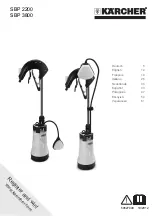
ENGLISH
– The three-phase motor must be protected by a circuit-breaker set to
the current marked on the motor data plate.
– The single-phase motor has built-in thermal protection.
– Provide a fuse disconnecting switch (type aM) to protect the power
supply.
Line power
– Use a cable meeting standard board.
•
THREE-PHASE
: 4 conductors (3 EARTH)
•
TWO-PHASE
: 3 conductors (2 EARTH).
A connection error would damage the motor. The power
cable must never touch the pipe or the pump; make sure
that it is away from any moisture.
The electric connections should be made as shown by the diagrams
inside the cover of the motor terminal box (or see figure 3).
– The electric motors used with pumps can be connected to a fre-
quency converter.
Strictly follow the directions given by the manufacturer’s data sheet.
– The converter must not generate voltage peaks at the motor termi-
nals higher than 850 V and dU/dt (Voltage/Time variation) higher than
2500 V/µs. If the value of the voltage signal are higher than those,
risk of damage the motor are to forecast.
If it does, place an LC (inductance-capacitance) filter between the
converter and the motor.
It must be connected to the motor with a minimum length cable,
armoured if necessary.
DO NOT FORGET TO CONNECT THE EARTH.
6. Starting up
6.1 Prior cleaning
An hydraulic test is canted out on each pump in our factory.
Some water stays inside them. It is recommended for hygien
reasons to clean the pump before using it on the potable
water supply.
6.2 Filling, degassing
Never operate the pump dry, even briefly.
Pump under pressure
(figure 2)
– Close the discharge valve (item 3).
– Open the suction valve (item 2).
– Unscrew the filling plug (item 5) on the main body of the pump.
– Put a funnel into the port and slowly and completely fill the pump and
the suction pipe.
– When water flows out and all air has been eliminated, filling is com-
plete.
– Screw the plug back in.
Pump in suction :
two cases are possible :
1st CASE
(figure 4-1) :
– Close the discharge valve (item 3).
– Open the suction valve (item 2).
– Unscrew the filling plug (item 5) on the main body of the pump.
– Put a funnel into the port and slowly and completely fill the pump and the
suction pipe.
– When water flows out and all air has been eliminated, filling is complete.
– Screw the plug back in.
2nd CASE
(figure 4-2) :
Filling can be made easier by fitting, on the pump suction pipe, a verti-
cal pipe with a stopcock and a funnel.
- Close the discharge valve (item 3).
- Open the suction valve (item 2).
- Unscrew plug (item 5).
- Fill the pump and the suction pipe completely, until water flows out of
the bleed device and all air bubbles have disappeared.
– Close the stopcock (which can be left in place), remove the pipe,
and screw the filling plug back in.
– Start the motor by pressing briefly, wait for 20’ to let air going up
WARNING!
inside pump housing.
– Unscrew once again the plug (item 5) and, if a water flow doesn’t
appear, remove plug and complete the water level inside the pump.
Close the plug and start again.
– If necessary, repeat this operation.
NOTE
: We recommend to protect the pump against dry-running with
an adequate device (automatic control, float switch, pressure switch).
6.3 Check dislocking and the motor sense of rotation
Whith an open-end screwdriver placed in the slot of the shaft on fan
side, make sure that the pump turns freely without sticking.
Switch on the motor by short pressing on the motor-overload release
and check that it turns in the direction indicated by the arrow located
on the indentification label of the pump.
If not, interchange two phase wires on the motor terminal block or cir-
cuit-breaker.
NOTE
: The single-phase motors are designed to turn in the right direc-
tion in all cases.
6.4 Starting up
Depending on conveyed fluid and running of pump, surface
temperature can exceed 68°C. Take necessary means to
avoid injuries.
The pump must not be operated in a no-flow condi-
tion (discharge valve closed) for more than 10 minu-
tes.
We recommend establishing a minimum flow of about 10 % of the
rated capacity of the pump, to avoid the formation of a gas pocket at
the top of the pump.
– Open the discharge valve to start the pump.
– Use a pressure gauge to check the stability of the discharge pressu-
re; if it is unstable, bleed the pump again or perform the filling opera-
tion.
– Check that the current draw does not exceed the value marked on
the motor data plate.
7. Servicing
Before any operation, switch off the pump(s).
No special servicing in operation. Always keep the pump perfectly
clean.
For a prolonged shutdown, if there is no risk of frost, it is best not to
drain the pump.
To avoid any blocking of the shaft and the hydraulic system, in frosty
periods, empty the pump by removing the plug (item 6) and the filling
plug (item 5). Screw the 2 plugs back in, without tightening them.
The replacement frequencies for the mechanical seal will depend on
pump operating conditions, namely:
• For the mechanical seal, the temperature and pressure of the liquid
pumped
• For the motor and other components, pressure head and ambient
temperature.
• Priming frequency, duty continuous or periodic.
The mechanical seal do not require special servicing in operation.
Bearings are lubricated for lifetime and do not require any lubrication.
WARNING!
11





































